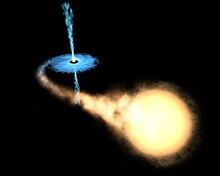User:HannahFord428/sandbox

In astrophysics, accretion is the growth of a massive object by gravitationally attracting more matter, typically gaseous matter in an accretion disc.[1] Accretion disks are common around smaller stars or stellar remnants in a close binary or black holes in the centers of spiral galaxies. Accretion may also refer to the extraction of gravitational potential energy from the attracted matter and its conversion into radiation (usually X-rays). Some dynamics in the disc are necessary to allow orbiting gas to lose angular momentum and fall onto the central massive object.
Example: The Jovian protoplanets probably had disks of their own, in close analogy to the Solar System as a whole. A Jovian protoplanet may accrete gas from its surrounding protoplanetary disk.
Dynamics[edit]
The rate of release of gravitation potential energy, also known as the accretion luminosity, is given by
where is the mass transfer rate on to a body with mass and radius R.
If we assume spherical symmetry and a steady state of accretion, the maximum luminosity for a given mass is given by the Eddington limit.
where is the mass of a proton, and is the Thomson scattering cross-section for an electron.
Accreting matter forms a disc when its specific angular momentum is too large to fall directly on to the accreting object. Matter in the accretion disc spirals in towards the accreting body, losing angular momentum which is transferred by viscous processes (the origin of which is a topic of ongoing research) to the outer orbits of the disc. As it loses gravitational potential energy, this is transformed into radiation. [2]
Accretion in binary systems[edit]
Binary systems give a lot of insight into the accretion process. Mass may be transferred due to one of the stars ejecting much of its mass as a stellar wind which is gravitationally attracted by its companion, or by the process of Roche-lobe overflow, when a stars grows enough that its outer layers are no longer gravitationally bound and may be accreted by its companion. [3]
White dwarfs[edit]
A binary system in which a white dwarf accretes matter from a close companion star is known as a "cataclysmic variable". Because these occur fairly regularly in our Milky Way, they provide the best opportunity to study accretion in an isolated system. [3]
Occasionally, this can result in stellar surface fusion. (See: Bondi accretion)
Neutron stars[edit]
When neutron stars are born in binaries that survive the supernova that creates them, accretion may occur through Roche Lobe overflow, or if part of the companion star's envelope is close enough for gas to fall on to the neutron star. If the magnetic field at the neutron star's surface exceeds 10^4 T, it can force the falling matter to flow along field lines to the star's magnetic poles. Friction within the gas as it spirals in can heat it to millions of degrees, causing the emission of X-rays. [4] When these X-ray emissions display strict periodicity, the stars are known as pulsars.
Black holes[edit]
We cannot see black holes or their event horizons, but we can see the matter accreting on to them. Extremely strong gravity leads to gas of very high temperatures, leading to X-ray emission and even gamma burts. (?)
Active galactic nuclei[edit]
Accretion on to supermassive black holes, at the centre of galaxies.
The most energetic and distant halos of matter around AGN are known as quasars.
See also[edit]
References[edit]
- ^ "Science with the VLTI". European Southern Observatory. 2008-08-08. Archived from the original on 24 May 2011. Retrieved 2011-04-11.
- ^ Israel, Gian Luca. "A Systematic Search of New X-ray Pulsators in ROSAT Fields". INAF Osservatorio Astronomico di Roma. Istituto Nazionale di Astrofisica. Retrieved 4 August 2014.
- ^ a b Frank, Juhan; King, Andrew; Raine, Derek (2002). Accretion Power in Astrophysics (Third ed.). Cambridge University Press.
- ^ Miller, Coleman. "Introduction to Neutron Stars". University of Maryland Astronomy. Retrieved 6 August 2014.
- ^ Abramowicz, Marek (January 2013). "Foundations of Black Hole Accretion Disk Theory". Living Reviews in Relativity. 16 (1): 1. arXiv:1104.5499. doi:10.12942/lrr-2013-1. PMC 5256006. PMID 28179840. Retrieved 7 August 2014.
[Category:Astrophysics]]






